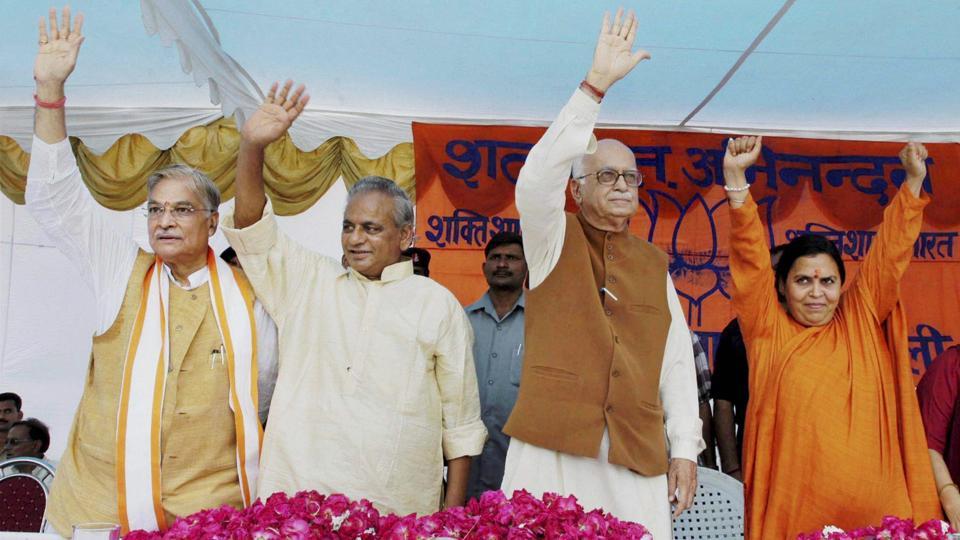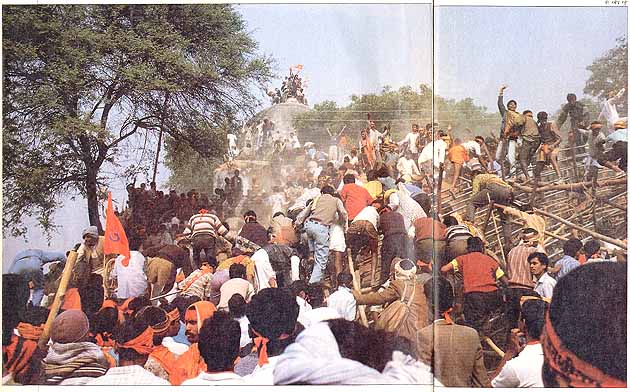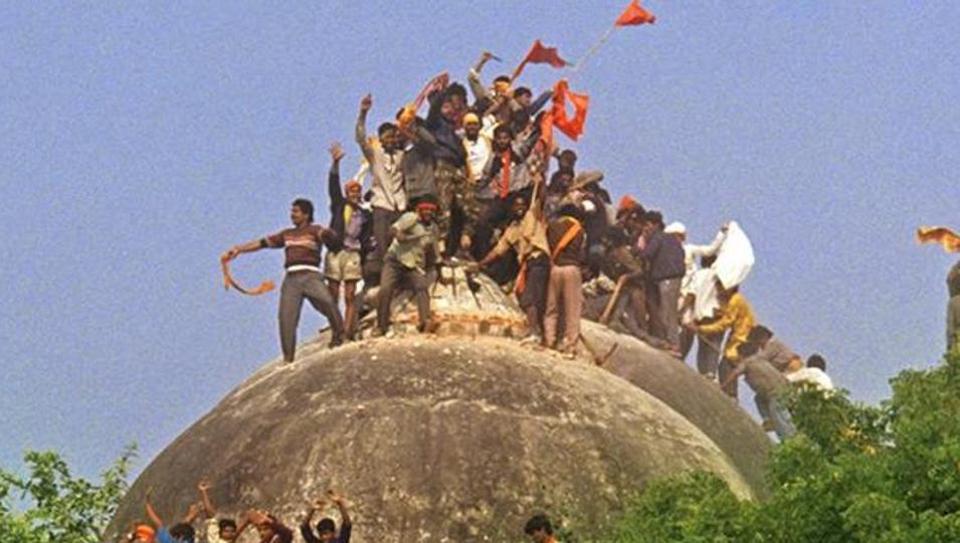Describing the demolition of Babri Masjid in Ayodhya as “Crimes which shake the secular fabrics of the Constitution of India”, the Supreme Court on April 19, 2017 put the senior BJP leaders L.K.Advani ,Murli Manohar Joshi and Union Minister Uma Bharti on a joint trial with ‘kar sevaks’ in the 1992 case under various charges , including criminal conspiracy to pull down the disputed structure. The Court also ordered restoration of charges against Rajasthan governor Kalyan Singh (who was Chief Minister at the time of demolition) and 8 others in connection with the case but exempted Kalyan Singh from prosecution on account of Constitutional immunity he enjoys as Governor. After this order of Supreme Court Uma Bharti and Kalyan Singh must have stepped down. On the other hand Uma Bharti raised the political pitch saying she never had any regrets about her role in bringing down the disputed Ayodha structure on Dec 1992. She said she had always been proud of her participation in the Ram Temple movement. “Na maine kabhi khed vyakt kiya hai , na maine kabhi mafi mangi hai” (neither have I expressed any regret, nor have I ever apologized),” she said.

The Indian Express dated April 20 , 2017 in its Editorial observed “Finally, the wheels of justice are turning in the Babri Masjid demolition case. The possibility of due process leading to justice and closure in one of the most seminal cases in India’s political history seems within reach now, 25 years after the 16th century mosque at Ayodhya was demolished by Sangh Parivar activists in the wake of the Rath Yatra of the-then BJP Chief L.K.Advani, shaming a nation and setting powerful new political dynamics in motion. The Supreme Court’s order on Wednesday sets back on track the judicial process and lays down conditions to ensure that the trial is not delayed or compromised further.”
Following the 1984 Elections in which Rajiv Gandhi had a clean sweep, BJP could secure only 2 seats in Lok Sabha. The Sangh Parivar started a campaign for the construction of a magnificent Ram Janam Bhoomi Temple at the site and by 1985 built up a sizeable support in the Hindu Community.In January 1986, locks were removed from the mosque and Ram bhakts were permitted to offer prayers to Ram lala .It is said that the Prime Minister Rajiv Gandhi ordered the Chief Minister Veer Bahadur Singh to do so who got the District Administration to ensure this .The two major political parties BJP and the Congress started a race on pandering to communal Hindu sentiments. In 1988 ,Hindutva Organizations led by the RSS organized a mass campaign for building a grand temple exactly where the Mosque stood. They claimed that the Mosque stood at the precise site where Ram was born.
Union Home Minister Buta Singh signed an agreement with the VHP on August 17, 1989,that bricks for constructing the temple would be allowed to be brought from all over UP without hindrance and collected at the plot No. 586 near the mosque .This agreement was in violation of an order of the Allahabad High Court given on August 14, 1989 that no construction activity could be taken at that spot.
Later ,the VHP announced that ‘kar sewa’ would be performed to lay the foundation stone .This was also a violation of the judgment given two days ago,prohibiting any such activity .This repeated defiance ,of the orders of the court did not weigh with the Prime Minister who inaugurated the campaign of Congress Party the next day from twin city of Faizabad, and announced that the objective of the party was to establish Ram Rajya. Soon thereafter the BJP President Advani, at Palampur ,after the National Executive Meeting ,announced that the inclusion of the construction of the temple in its Election Manifesto "would fetch votes" for it. It would thus appear that the two major political parties were in a race to gain political mileage from this issue between 1984 and 1989.
Looking back at the developments around 1989, we are reminded how Mandalisation was made an effective issue by the casteist forces in answer to BJP’s Kamandalisation. Very soon, casteist forces came to acquire political legitimacy by projecting themselves as political forces opposed to communalism, and in order to appear so, they masked themselves as “secularists”, though the truth was that they had discovered “caste politics” as a potent instrument to win success at elections without even doing anything while in power for solving the basic problems of the masses. There emerged a consensus among various political parties to maintain their vote banks by dividing the people on caste and communal lines. Non-performance by a party in power became irrelevant because of its potential to work out a favourable caste arithmetic and win elections. Communalism on the one hand and casteism on the other thus acquired a firm sway over the Indian polity. If anything, it were the three C’s—centralisation, corruption and criminalisation—coupled with the caste and communal divide, engineered by opportunistic political forces as the shortest route to quick success, which made all the relevant issues, concerning the public, irrelevant. While corruption and criminalisation sapped the soul out of the ideal of people-oriented democratic governance, centralization of political authority led to an unaccountable bureaucratization of governance.
In this backdrop the movement to construct a Ram temple at the sight of the Mosque also gathered momentum in 1989 and has continued till 1992. The Supreme Court in M.Ismail Farooqui vs UOI,(AIR 1995 SC 605) noticed: “A new dimension was added to the campaign for the construction of the temple with the formation of the Government in Uttar Pradesh in June 1991 by the Bhartiya Janta Party (BJP) which declared its commitment to the construction of the temple………….The focus of the temple construction movement from October 1991 was to start construction of the temple by way of ‘kar-sewa’ on the land acquired by the Government in Uttar Pradesh while leaving the disputed structure intact. ….There was a call for resumption of kar sewa from December 6, 1992 and the announcement made by the organizers was for a symbolic kar-sewa without violation of the court orders including those made in the proceedings pending in this court. Inspite of initial reports from Ayodhya on December 6, 1992 indicating an air of normalcy, around mid-day a crowd addressed by leaders of BJP, VHP, etc., climbed the Ram Janma Bhoomi – Babri Masjid (RJB-BM) structure and started damaging the domes. Within a short time, the entire structure was demolished and razed to the ground. Indeed it was an act of “National Shame” what was demolished was not merely an ancient structure ; but the faith of minority in the sense of justice and fair play of majority. It shook their faith in the rule of law and constitutional processes. A five hundred year old structure which was defenceless and whose safety was a sacred trust in the hands of government was demolished.”

In a speech from the Red Fort in Delhi on August 15, 1992 which was broadcast , the Prime Minister P.V. Narasimha Rao had already said that “The Babri Masjid structure will be protected and the Ram temple built”. This assurance would lead people to draw a conclusion that the Ram Temple was not to be built on the site of the Babri Masjid because that structure was to be protected. The destruction of the Babri masjid had deeply wounded the religious feelings of the Muslim community throughout india and the least that could be done to sooth those injured feelings was to assure the community that the Babri Masjid was to be rebuilt. The Prime Minister gave that assurance on Dec 7 ,1992, and he referred to it on February 7 , 1993 in the BBC ‘Phone-in programme’ . He said “ I thought it was necessary, it was my duty to rebuilt the Mosque.”
“ The judgments delivered by the Lucknow Bench of Allahabad High Court on September 30, 2010 on the Babri Masjid cases not only flagrantly violate the law and the evidence but a binding unanimous judgment of the Supreme Court on the Babri Masjid case itself (M. Ismail Faruqui and Others vs Union of India and Others (1994)6 Scc 360. It sanctified the conversion of a historic mosque ,which stood for 500 years into a temple.” Said A.G.Noorani in his article “Muslims Wronged” in Oct 22 ,2010 issue of Frontline . Noorani further says in the same article , “On the Babri Masjid ,for 60 years from 1950 to 2010, Muslims have been woefully wronged by every single court ruling ,including that of the Supreme Court after the demolition of the mosque on December 6, 1992”.
An eminent jurist and Senior Advocate of Supreme Court T.R.Andhyarujina in his article (The Hindu ) Oct 5, 2010 said “The absence of any condemnation of the vandalism of the demolition of the Babri Masjid on Dec 6, 1992 is a conspicuous aspect of the Ayodhya verdict of the Allahabad High Court .” T.R.Andhyarujina further says in the same article : “The Ayodhya judgments of the Allahabad High Court make no note of the vandalism of Dec 6, 1992 .On the other hand ,they take the demolition as a fait accompli, as if the disputed 2.77 acre site was vacant land .After holding that the area beneath the central dome of the erstwhile Masjid must be allotted to Hindus because of their faith that Lord Ram’s place of birth was there ,and the areas covered by the Ram Chabutara and Sita Rasoi should be allotted to the Nirmohi Akhara ,the court has said that the remaining area of the disputed site should be divided, two-thirds to the two Hindu plaintiffs and one third to the Muslim plaintiff by metes and bounds .These judgments, therefore legalise and legitimise the 1992 demolition, as the decree of the court proceeds on the basis that there is no Masjid on the disputed site today.
It is an elementary rule of justice in courts that when a party to a litigation takes the law into its own hands and alters the existing state of affairs to its advantage,(as the demolition in 1992 did in favour of the Hindu plaintiffs ), the court would first order the restitution of the pre-existing state of affairs .”
H.M.Seervai ,one of the most distinguished constitutional lawyer in a two-part article “Babri masjid” published in Economic Times on April 9 and 10, 1993, said:
“The destruction of the Babri Masjid put an end to all previous controversies raised by Hindu organisations about their alleged rights to erect a temple on the place where Babri Masjid stood. This is because no Court will give any assistance to those who unilaterally by criminal acts destroyed the subject matter of this dispute and violated the constitution and the law .”
The Allahabad High Court verdict came on September 30, 2010 during UPA-II regime. After Allahabad High Court judgment a grave and serious danger to Indian democracy appeared on the horizon. This verdict gave a legal shape to the political agenda of the Sangh Parivar “Mandir wahin Banaenge” and has legitimised the Masjid demolition on December 6, 1992 giving them a way to claim to construct a “Grand Temple” at the sight of the demolished Masjid and gave a boost to the BJP to contest 2014 Elections based on this issue.
Although against the Allahabad High Court judgments many appeals were filed in the Supreme Court (which are still pending), and the question as to whether they could construct a temple at the site of the Mosque had yet to be finally decided by the Supreme Court, the Sangh Parivar continued with their campaign for 2014 elections that they would construct a Grand Temple . This judgment gave strength to the BJP and the power behind it- the RSS and the Sangh Parivar consisting of such organization as the Akhil Bhartiya Vidyarthi Parishad, the VHP and the Bajrang Dal. They gave to Indian politics a heady mixture of aggressive hindu communalism and an equally aggressive hindu nationalism. In that process they promoted enemity between the Hindus and the Muslims. The movement fostered by these forces contains all the essential characteristics of fascism.
It was after about three and a half months from December 6, 1992 and the demolition of the Babri Masjid, that the 13th J.P.Memorial Lecture was delivered by V.M.Tarkunde on March 23, 1993. The subject of the lecture was Communalism and Human Rights . V.M. Tarkunde said in that lecture: “ I am of the view that the communalist nationalism which is being propagated by the BJP and the Sangh Parivar represents a far greater danger to Indian Democracy than the personal authoritarian rule which Mrs. Indira Gandhi and the Gandhi-Nehru family were likely to impose on the country. A personal authoritarian rule is a lesser danger because it is largely external to the people. Most of the people do not approve it, although they are usually too afraid to stick out their necks and openly oppose it ….Communalism, however , particularly when it is the communalism of the majority and can therefore take the form of ardent nationalism as well , can find a positive response in the minds of the people who are still prone to religious blind faith and among whom the humanist values of democracy , i.e, values of liberty, equality and fraternity are yet to be fully developed. Communalism in such cases is an internal enemy in the human mind and it is far more difficult to eradicate it than an external enemy like an autocratic ruler .” V.M. Tarkunde cautioned about the possibility of the BJP coming into power in the next elections (after demolition of the Mosque in Dec 1992). In this context he said in his memorial speech “as the Congress –(I) is now much weaker than before and the opposite parties are unable to unite –to form an anti-communal secular platform , the BJP expects to come to power in the next election. If this happens , the secular democracy in India is liable to be replace by a potentially fascist theocratic state.” However , it did not so happen in the next election. But in 1999 BJP led coalition NDA formed the govt. with Atal Bihari Vajpayee as Prime Minister,with a strong opposition in Parliament. What VM Tarkunde apprehended in 1993 did happen in 2014: with the the victory of Modi with a huge margin to Parliament and faced with a weak and divided opposition.

Now after three years of the victory of Modi in the Centre , Yogi Adityanath, a Hindu icon has been elected as the leader of Uttar Pradesh Legislative Party and installed as Chief minister .The BJP has secured a majority of 325 members in the Legislative Assembly having the strength of 403 . Yogi has the reputation of being a hardcore Hindu leader . His becoming the Chief Minister shows that Hindutva is sweeping the country. It also shows that secularism has not taken roots in our country. The Hindutva elements are gradually sweeping the country. These developments are a serious threat to the state of human rights in the country and all concerned citizens need to seriously give a thought to how they have to meet this grave challenge.